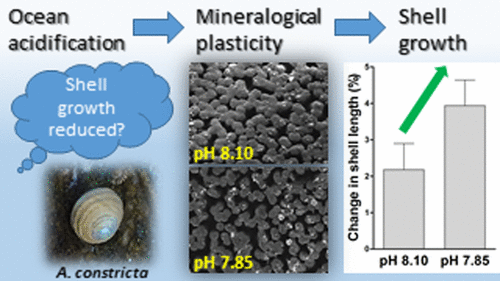Credit: American Chemical Society
As the world continually emits carbon dioxide into the atmosphere, the oceans are taking a hit, absorbing some of it and growing more acidic. Among other effects, scientists have found that coral reefs and oyster hatcheries are deteriorating as a result. However, scientists studying a type of sea snail report a bit of bright news in the ACS journal Environmental Science & Technology: The animal can adapt by rejiggering its shell-making process and other functions.
A lower pH in ocean waters means fewer carbonate ions are available to calcifying organisms, such as coral reefs and oysters, which need the ions to produce shells and skeletons. While ocean acidification appears to cause damage to many calcifying organisms, recent studies have suggested that some of those organisms may be more resistant to acidification than previously thought. Sean D. Connell and colleagues wanted to find out how this might be possible.
The researchers exposed sea snails called periwinkles to the ocean conditions predicted for 2100, when some waters at a pH of 8.10 today are expected to reach a pH of 7.85. Although the animals' metabolism declined, they were able to speed up their shell-making by producing less-dense inner shells. In addition, they developed less-soluble shells, which are more resistant to future, harsher ocean conditions. The researchers say these changes suggest that the periwinkle, and potentially other calcifying organisms, could have the ability to adapt to the acidifying oceans.
More information: Mineralogical Plasticity Acts as a Compensatory Mechanism to the Impacts of Ocean Acidification, Environ. Sci. Technol., Article ASAP. DOI: 10.1021/acs.est.6b04709
Abstract
Calcifying organisms are considered particularly susceptible to the future impacts of ocean acidification (OA), but recent evidence suggests that they may be able to maintain calcification and overall fitness. The underlying mechanism remains unclear but may be attributed to mineralogical plasticity, which modifies the energetic cost of calcification. To test the hypothesis that mineralogical plasticity enables the maintenance of shell growth and functionality under OA conditions, we assessed the biological performance of a gastropod (respiration rate, feeding rate, somatic growth, and shell growth of Austrocochlea constricta) and analyzed its shell mechanical and geochemical properties (shell hardness, elastic modulus, amorphous calcium carbonate, calcite to aragonite ratio, and magnesium to calcium ratio). Despite minor metabolic depression and no increase in feeding rate, shell growth was faster under OA conditions, probably due to increased precipitation of calcite and trade-offs against inner shell density. In addition, the resulting shell was functionally suitable for increasingly "corrosive" oceans, i.e., harder and less soluble shells. We conclude that mineralogical plasticity may act as a compensatory mechanism to maintain overall performance of calcifying organisms under OA conditions and could be a cornerstone of calcifying organisms to acclimate to and maintain their ecological functions in acidifying oceans.
Provided by American Chemical Society
























